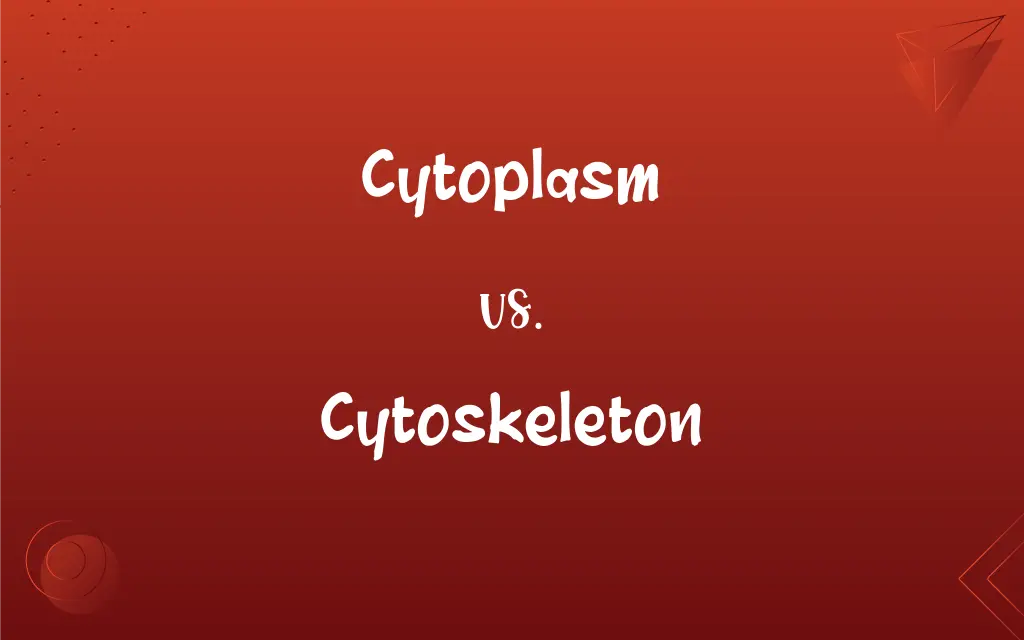Cytoplasm vs. Cytoskeleton: What's the Difference?
Edited by Janet White || By Harlon Moss || Updated on October 28, 2023
Cytoplasm is the gel-like substance within a cell enclosing organelles; cytoskeleton is the cell's structural framework of protein filaments.

Key Differences
Cytoplasm refers to the gelatinous substance that fills the cell, acting as a medium for cellular components. In contrast, the cytoskeleton is a network of protein filaments and tubules that provides structural support and shape to the cell. The cytoplasm encompasses everything within the cell membrane excluding the nucleus, while the cytoskeleton is an integral part of this content, giving cells rigidity and facilitating movement.
Within the cytoplasm, numerous cellular processes occur, including metabolic reactions and signal transduction. This environment houses various organelles like mitochondria and the endoplasmic reticulum. On the other hand, the cytoskeleton's primary role is to maintain cell structure, aid in intracellular transport, and enable cellular motility. This framework consists of different protein structures like microtubules, actin filaments, and intermediate filaments.
The cytoplasm serves as the environment in which organelles can function and carry out their roles. It consists of water, salts, and organic molecules, making it conducive for biochemical reactions. In contrast, the cytoskeleton, while embedded within the cytoplasm, acts as the cell's skeleton. It facilitates the cell's dynamic nature, allowing it to divide, move, and maintain its shape.
To better understand the relationship between the cytoplasm and the cytoskeleton, consider a city analogy. If the cytoplasm were the atmosphere and terrain of a city, housing buildings (organelles) and facilitating various activities, the cytoskeleton would be the city's infrastructure—like roads and bridges—supporting structures and enabling movement.
Comparison Chart
Definition
Gel-like substance inside a cell
Network of protein filaments in a cell
ADVERTISEMENT
Components
Water, salts, organelles, molecules
Microtubules, actin filaments, intermediate filaments
Function
Medium for cellular reactions
Provides structural support, facilitates movement
Location
Fills the cell excluding the nucleus
Embedded within the cytoplasm
Physical State
Gel-like, semi-fluid
Solid, filamentous structures
Cytoplasm and Cytoskeleton Definitions
Cytoplasm
Cytoplasm is the fluidic substance within cells.
Organelles are suspended within the cytoplasm of the cell.
ADVERTISEMENT
Cytoskeleton
Cytoskeleton assists in intracellular transport.
Vesicles move along the cytoskeleton's tracks to reach their destinations.
Cytoplasm
Cytoplasm acts as the medium for cellular activities.
Enzymatic reactions often take place in the cytoplasm.
Cytoskeleton
Cytoskeleton provides structural support to cells.
The cell's shape is maintained by its cytoskeleton.
Cytoplasm
Cytoplasm contains both organic and inorganic components.
The cytoplasm is rich in proteins, ions, and other molecules.
Cytoskeleton
Cytoskeleton networks are dynamic and can be remodeled.
Stimuli can cause the cytoskeleton to reorganize, altering the cell's shape.
Cytoplasm
Cytoplasm facilitates the transport of materials within the cell.
Nutrients diffuse through the cytoplasm to reach various parts of the cell.
Cytoskeleton
Cytoskeleton comprises protein filaments and tubules.
Microtubules, a component of the cytoskeleton, help in cell division.
Cytoplasm
Cytoplasm supports and protects cell organelles.
Like a cushion, the cytoplasm buffers organelles against damage.
Cytoskeleton
Cytoskeleton is essential for cell movement and division.
Without a functional cytoskeleton, cells wouldn't be able to migrate.
Cytoplasm
The protoplasm enclosed by the plasma membrane of cell, excluding the nucleus in eukaryotic cells and cellular DNA in prokaryotic cells.
Cytoskeleton
The internal framework of a eukaryotic cell, composed of protein filaments that provide structural support and drive the movement of the cell and its internal components, typically divided into three categories (microfilaments, intermediate filaments, and microtubules) based on the diameter and composition of the filaments.
Cytoplasm
(cytology) The contents of a cell except for the nucleus. It includes cytosol, organelles, vesicles, and the cytoskeleton.
Cytoplasm
The substance of the body of a cell, as distinguished from the karyoplasma, or substance of the nucleus.
Cytoplasm
The protoplasm of a cell excluding the nucleus
FAQs
What are the main components of the cytoskeleton?
The cytoskeleton comprises microtubules, actin filaments, and intermediate filaments.
How is the cytoskeleton different from the cytoplasm?
The cytoskeleton is a structural network of protein filaments in a cell, while the cytoplasm is the cell's internal fluidic environment.
What happens if the cytoskeleton is damaged?
If the cytoskeleton is damaged, cells may lose their shape, motility, and even the ability to divide.
Is the cytoplasm only water?
No, besides water, the cytoplasm contains salts, organelles, and organic molecules.
Does the cytoplasm play a role in cell signaling?
Yes, many signaling molecules and pathways are located and activated within the cytoplasm.
How do drugs or toxins affecting the cytoskeleton impact cells?
Toxins targeting the cytoskeleton can disrupt cell shape, movement, and division, leading to cell dysfunction or death.
What is the cytoplasm?
Cytoplasm is the gel-like substance inside a cell that houses organelles and facilitates cellular reactions.
Does the cytoskeleton interact with other cellular components?
Yes, the cytoskeleton interacts with organelles, membranes, and other structures to facilitate cell processes.
Can substances move freely in the cytoplasm?
While many substances can diffuse within the cytoplasm, the cytoskeleton and organelles can influence their movement.
How do cells regulate the cytoskeleton?
Cells use various proteins and signaling pathways to assemble, disassemble, and reorganize the cytoskeleton.
Can the cytoskeleton conduct signals?
Yes, the cytoskeleton can participate in signal transduction and transmit mechanical signals within cells.
Why is the cytoskeleton important for cell movement?
The cytoskeleton provides structural pathways and support that enable cells to move and change shape.
Do plant cells have a cytoplasm and cytoskeleton?
Yes, both plant and animal cells have cytoplasm and a cytoskeleton, although their structures and functions may differ slightly.
How does the cytoskeleton assist in cell division?
The cytoskeleton reorganizes during cell division, especially microtubules, to help separate chromosomes and divide the cell.
Is the cytoplasm the same in all cells?
While the basic function and components of the cytoplasm are similar, its exact composition can vary among cell types.
Is the nucleus part of the cytoplasm?
No, the nucleus is a distinct organelle, and the cytoplasm surrounds it.
Are cytoplasm and cytosol the same thing?
No, while cytoplasm refers to everything inside the cell membrane excluding the nucleus, cytosol is the fluid portion of the cytoplasm without the organelles.
Why is the cytoskeleton described as dynamic?
The cytoskeleton is termed dynamic because its structures can be rapidly assembled and disassembled based on cellular needs.
Can cells exist without a cytoplasm?
No, the cytoplasm is essential as it houses organelles and supports cellular activities.
Can the composition of the cytoplasm change?
Yes, the cytoplasm's composition can vary depending on the cell type and its physiological state.
About Author
Written by
Harlon MossHarlon is a seasoned quality moderator and accomplished content writer for Difference Wiki. An alumnus of the prestigious University of California, he earned his degree in Computer Science. Leveraging his academic background, Harlon brings a meticulous and informed perspective to his work, ensuring content accuracy and excellence.
Edited by
Janet WhiteJanet White has been an esteemed writer and blogger for Difference Wiki. Holding a Master's degree in Science and Medical Journalism from the prestigious Boston University, she has consistently demonstrated her expertise and passion for her field. When she's not immersed in her work, Janet relishes her time exercising, delving into a good book, and cherishing moments with friends and family.































































